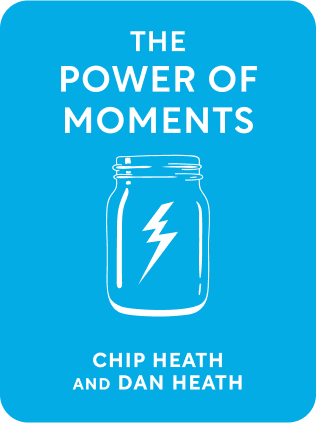

This article is an excerpt from the Shortform book guide to "The Power of Moments" by Chip Heath and Dan Heath. Shortform has the world's best summaries and analyses of books you should be reading.
Like this article? Sign up for a free trial here .
Have you ever had an “aha!” moment? What do you think prompted your aha realization?
Aha moments inspire realizations or transformations that affect your future choices and actions. Such moments usually strike spontaneously, but you can also engineer them on demand. In their book The Power of Moments, Chip and Dan Heath explain how to prompt moments of discovery that deliver a shock that may change your way of thinking or even the course of your life.
In this article, we’ll explore the three ways Heaths suggest that you can spark the aha moment on demand.
Strategy 1: Force Someone to Confront a Truth
The Heaths first explore how you can spark the aha moment in others by setting up a situation in which they will be forced to confront an uncomfortable truth. They note three essential factors to making the moment defining:
- Have a clear conclusion: Know exactly what conclusion you want your audience to come to. This is often the easiest part of the process—you usually know exactly what truth needs revealing.
- Operate on a short time frame: Create a situation that will guide your audience to their discovery over a matter of minutes or hours, or even more immediately.
- Allow audience discovery: Let the audience discover the conclusion themselves, instead of telling them what to do.
These factors result in an “aha! moment,” or what psychologist Roy Baumeister dubbed the crystallization of discontent: a sudden moment in which any vague negativity or discomfort you’re feeling suddenly crystallizes in a pattern—you discover links between seemingly unrelated issues and the core problem becomes startlingly clear. The crystallization of discontent often provides a crucial burst of motivation to make a major change, such as someone leaving her abusive spouse, cult members leaving their organization, or alcoholics deciding to start recovery.
| Why These Three Factors? These three factors are crucial to creating insight because together, they replicate the conditions of a spontaneous crystallization of discontent. In her book Radical Acceptance, author Tara Brach discusses the Alcoholics Anonymous program, which notes that an addict begins changing when they hit rock bottom, an experience that echoes the Heaths’ three factors: 1) They realize that their lives are not within their control (an instantaneous realization, or a short timeline). 2) They understand that they must make a change to their lifestyle (a clear conclusion). 3) They have to come to this realization on their own—addiction support organizations stress that the addict is the only person who can take on the recovery process. In other words, they can’t get help until they understand the problem and decide to treat it themselves. |
Strategy 2: Set Up a Situation for Self-Insight
The Heaths explain that using insight to create defining moments for yourself depends on pushing your boundaries—you must put yourself in situations that expose you to the possibility of failure. This is because the process of stepping outside of your comfort zone and risking failure leads to what psychologists call “self-insight”: an understanding of your values, abilities, goals, and motivations.
How Risking Failure Translates Into Valuable Self-Insight
Exposing yourself to the risk of failure can only go one of two ways: either you succeed, or you fail. While these outcomes may not seem equally valuable, the Heaths assert that both should be celebrated as valuable learning opportunities.
It’s obvious why exposing yourself to the risk of failure and then succeeding would be a cause for celebration. It stirs up positive emotions, bolsters your confidence in your abilities, and at times can prompt positive changes in your life.
- For example, while doing volunteer work on the weekends you realize, “This is exactly what I want to spend the rest of my life doing! How can I make this my full-time job?”
(Shortform note: This type of discovery—realizing how you want your future to be, and therefore making positive changes in the interest of working toward a goal rather than pushing away from past behavioral patterns—can be understood as a crystallization of desire, an inverse of the crystallization of discontent.)
It’s much less obvious why risking failure—and then actually failing—is also something to celebrate (or at least, not dread). Failure certainly doesn’t stir up the same sort of positive emotions as success. However, the Heaths emphasize that negative emotions are especially helpful in creating meaningful moments defined by insight.
The Heaths go on to discuss the two possible conclusions that this “warning” prompts:
Conclusion A: The cost is worth it. You realize that you are strong enough to endure the cost of the experience and are willing to do it again, even if you risk feeling negative emotions again.
- A sprinter experiences a humiliating defeat. She thinks to herself, “That was awful, but if I can push through that, I can push through anything.” She’s dedicated enough to continue the sport, even if it means experiencing failure again in the future.
Conclusion B: The cost is too high. You realize that the cost of the experience is too high, and you don’t want to risk feeling these emotions again. You experience your crystallization of discontent.
- Imagine that you leave your corporate job to become the owner of a coffee shop. You like the work and you’re proud to have your own business, though the customers are demanding and the hours are very long, you’ve been having trouble finding good baristas to work for you, and the income is unpredictable. One day, you’re frazzled and you accidentally grab a cake out of the oven without a mitt, burning yourself badly. Suddenly, you realize, “I hate this job. I’m so stressed out all the time and I miss the structure of the office.” Your crystallization of discontent leads you to sell your coffee shop and head back into the corporate world, where you are much happier. You realized that the cost of owning a coffee shop was too high, and not something you wanted to experience any longer.
Strategy 3: Push Others Into Their Self-Insight as a Mentor
As a mentor, your job is to push your mentee into situations that will spark her self-insight, providing the type of productive pressure that helps coax out her best self. The Heaths note that great mentors usually issue challenges to their mentees with a four-part formula: high expectations + confidence + direction + support. Each part of this formula is important: High expectations alone can make people feel defensive or intimidated, but expressing confidence in them can attach a sense of empowerment to the message. Adding the elements of direction and support elevates the message of the mentor even further: “I have high expectations but I know you are capable of reaching them. Here’s a challenge that I think you should take on. If you need any help, let me know and I will have your back.”
- High expectations: You’ll have to stretch to meet them.
- Confidence: I know you are capable.
- Direction: Here’s a challenge I think you should take on.
- Support: I will have your back.
The Heaths concede that using all four aspects of the mentorship formula will require a good deal of effort—you’ll need to scope out appropriate challenges for your mentee, and you must be ready to lend support when it’s needed. This extra work is worth it: Under the guidance of a mentor who applies productive pressure and will help them recover from failure, mentees are more confident in taking on the types of challenges that expose them to risk, therefore multiplying their opportunities for moments of self-insight.
Example: Encouraging Improvement as a Coach
Imagine two scenarios in which you’re a coach, trying to get a sprinter on your team to improve her time in the 400m race:
Scenario A: You say, “My fastest sprinters are running the 400m race 15 seconds faster than you. Work harder and keep up!”
- In this scenario, you apply high standards only. As a result, your message comes across as harsh and condescending, and she responds with defensiveness. She thinks, “Coach is picking on me because she doesn’t like me. There’s no use trying to improve—she’ll never like me as much as the fastest sprinters.”
Scenario B: You say, “I want you to improve your 400m time by at least 15 seconds. I know you can do it—I can see you have the potential to be one of my best sprinters. I know a group of your top teammates practice together on Saturdays, and I’d suggest asking if you can train with them. I’m here to get you on—or even past—their level, so don’t be afraid to ask for my help.”
- In this scenario, your high standards were followed up with assurance, clear direction, and a reminder of your support. In this way, you’ve reframed your standards as an attainable goal. Your sprinter thinks, “I’m not the fastest right now, but Coach thinks I can improve, or even excel, with some dedicated practice. I’ll ask her to help me come up with a training plan so I can get there.”
| Helpful Guidelines for Choosing Appropriate Challenges As a mentor, you may work with a mentee who isn’t on the exact path you chose—as a result, you might find it difficult to determine which challenges are “right” for her. Two guidelines to work within are those of your mentee’s ambitions and the limits of her ability. 1) Consider her ambition: Talk to your mentee about what her ambitions are, and shape your challenges accordingly. Kim Scott in Radical Candor discusses two types of team members who are well-positioned to handle new challenges but have very different ambitions: superstars and rockstars.Superstars are those mentees who are high performing and very ambitious—they want challenges that will allow them to take on new roles, develop their skills quickly, and boost them to the top of their field. Rockstars are those mentees who are high performing but like where they are—they want challenges that keep things interesting and develop their skills, but don’t disrupt their status quo too much. 2) Give “Goldilocks” challenges: This concept, from Daniel Pink’s Drive, means directing your mentee toward projects that are challenging enough to stay interesting, but not so challenging that they become overwhelming. Choose a challenge that pushes the upper limit of her abilities but doesn’t go beyond it. |
Let Failures Happen
The Heaths stress that “support” doesn’t mean shielding your mentee from all risk. It’s critical that your mentee be exposed to the risk of failure in order to achieve self-insight. This is difficult, as it goes against all instinct. Naturally, we want to protect those we’re helping.
As a mentor, your goal shouldn’t be to protect your mentee from failure, or the results of their failure. Instead, your goal should be to normalize failure—don’t shame your mentee for it but talk to them about ways they might recover from it. In turn, your mentee will stretch for novel experiences that will continue to reward them with defining moments of self-insight.
| How to Talk About Failure The Heaths encourage you to normalize failure instead of shielding your mentee from it but don’t fully cover how you might do this. As Carol S. Dweck explores in Mindset, the way you respond to your mentee’s failure is key in determining whether or not she will grow from the experience. For example, imagine she auditioned for a role but didn’t make the callback. You’ll likely be tempted to respond in one of the following fixed-mindset ways that serve to shield her from her failure: “Well, I thought you were the best audition.” (She knows this isn’t true.)“They must have a deal with one of the others. Otherwise, they’d have picked you.” (She understands she can shift blame to others instead of taking ownership of her failure.)“You’re so talented—you’ll definitely get the next one.” (She learns that talent is the only thing that matters.)“Musical theatre isn’t important anyway, don’t waste any more time thinking about it.” (She internalizes the message that anything she’s not good at isn’t worth her time.) Instead, choose to respond in a way that acknowledges her failure rather than sugar-coating it. This helps her learn from the experience and, more importantly, encourages her to continue trying: “You tried your best, but the other actors at the audition had more musical theater experience. Keep practicing with your weekly group and you’ll move up into their ranks.” |

———End of Preview———
Like what you just read? Read the rest of the world's best book summary and analysis of Chip Heath and Dan Heath's "The Power of Moments" at Shortform .
Here's what you'll find in our full The Power of Moments summary :
- How to make everyday experiences meaningful and memorable
- A look at the four elements that create meaning
- How your senses can play a role in elevating everyday moments






